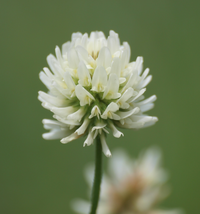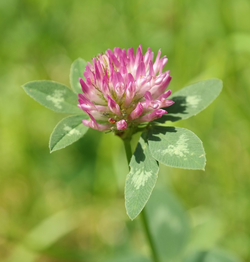Clover

This is about clover for breast enlargement, and about its hormonal properties for hormone balance.
Etymology
Clover is a plant genus that goes by the scientific name of Trifolium. It belongs to the Fabaceae family, also known as the Leguminosae (legume) or pea family.
Clover Disease

"Clover disease" is a common ailment of birds and livestock who consume excessive amounts of clover, causing reproductive problems, including reduced gonad size, and reduced fertility. Clover disease can even eventually cause sterility, and this is a concern for humans too.
Clover's negative effects are possibly due to ERβ desensitization. Trifolium is expected to cause hormone imbalances if taken during menses, proliferative phase and premenstrual phase. Hormones must be balanced.
Red Clover; Trifolium pratense

Red Clover (Trifolium pratense) is one of the most popular varieties of Clover used for hormonal issues. It is known as a rich source of phytohormones.
Use
Trifolium for breast enhancement
While clover can cause breast enhancement during menses, it should be avoided for this phase, because it can contribute to heavy menstruation. Heavy menses, especially that is prolonged, is not sustainable for hormonal health.
Taking clover during proliferative phase or ovulation will cause shrinkage, and will contribute to hormone imbalance.
Clover requires the right companion herbs during secretory phase, when there's no swelling.
This herb should be avoided during menses, proliferative phase, and premenstrual phase.
From the above ground parts of the clover plant, the leaf has a higher density of phytohormones, and the flower has the least. If clover is used, the lowest potency is desired.
Trifolium or herbs with similar properties are in herb programs based on menstrual phases. There must be balance throughout phases, and combinations of herbs help the body acheive balance for health, breast growth and hip growth. It's important that menses is light and short. Also, preventing an excess of negative symptoms for menses helps set the balance for proliferative phase. Luteal phase uses a different combination of herbs than proliferative phase for symptoms. For a simplified herb schedule, where there's commonality of herb recommendations for symptoms such as swelling and signs of excess estrogen, use nonmenses. BCP01 is a composite page of pieces of different programs on birth control or IUD use.
Herb timing and combinations' success for breast enhancement relies on menstrual phases. Descriptions and pictures of results from herb combination use can be seen in programs. For more guidance, see guide, or hirsutism-topic.
Similar herbs
Fenugreek (Trigonella), milk thistles (Silybum), shatavari (Asparagus) and kudzu (Pueraria) are suitable replacements for clover, because they also have progestogenic properties which offer more balance.
Because the effects of hops (Humulus) are less pronounced on ERβ which is primarily expressed in the reproductive tract, it is a good replacement for clover. Hops requires different companion herbs.
Precautions
See precautions for more details of care to be taken with herb use. Proper nutrition is a consideration for health. Also, check for the latest blog updates about herb and hormone safety.
It is very important that menses be light and not prolonged.
If you have hirsutism, PCOS, hot-flashes, other signs of hormone imbalances, see estrogen-imbalance, and hirsutism program journals at hirusitism-topic before trying herbs.
Herb concentrates can be tens of times more potent by weight than herbs in solid form. This can easily lead to hormone imbalances. For this reason, concentrate extracts are not recommended for extended or excessive internal use, especially during fertility years. Concentrates shouldn't be used to overcome plateaus. Another issue with herbal extracts, is that they may not have the full range of properties of the herb. Essential oils are not recommended for breast enhancement. If opting to use herbal extracts, use food grade extracts, with no more than 1 drop at a time diluted in water.
More


For the latest herb programs and how to get started, see: guide. Pictures of breast enhancement can be seen in the program journals of Anon02, Anon08, Anon09, Bubblemelon and Jellie.
For resources on hips and butt enhancement, see: /appendix/hips-butt-enhancement and /appendix/kettlebell.
breast-endocrinology.pdf describes the science of breast development and endocrinology. It also describes symptoms related to hormone imbalances. Biology and hormone imbalances are excerpts from this ebook. breast-endocrinology.pdf uses a Creative Commons (CC BY-ND 4.0) license.
Breast.is blog
References:
- Berry W, Denison MS, Klasing KC, Millam JR, Rochester JR, Stevenson L. Dietary Red Clover (Trifolium Pratense) Induces Oviduct Growth and Decreases Ovary and Testes Growth in Japanese Quail Chicks. Reprod Toxicol. 2008[2009];27(1). http://www.ncbi.nlm.nih.gov/pmc/articles/PMC2858001/.
- E Poluzzi, Carlo Piccinni, E Raschi, A Rampa, M Recanatini, FD Ponti. Phytoestrogens in Postmenopause: The State of the Art from a Chemical, Pharmacological and Regulatory Perspective. Curr Med Chem. 2014 Feb; 21(4): 417–436. https://www.ncbi.nlm.nih.gov/pmc/articles/PMC3963458/.
- Persistent infertility in ewes after prolonged exposure to oestradiol-17 beta : progesterone and estrogen together reduced fertility more than just either alone. http://www.reproduction-online.org/content/84/1/373.long.
- Wellness Mama. http://wellnessmama.com/26519/risks-essential-oils/.
Etymology & Definitions:
- Trifolium L. clover. http://plants.usda.gov/core/profile?symbol=TRIFO.
- U.S. National Plant Germplasm System: Fabaceae. https://npgsweb.ars-grin.gov/gringlobal/taxonomyfamily.aspx?id=440.
